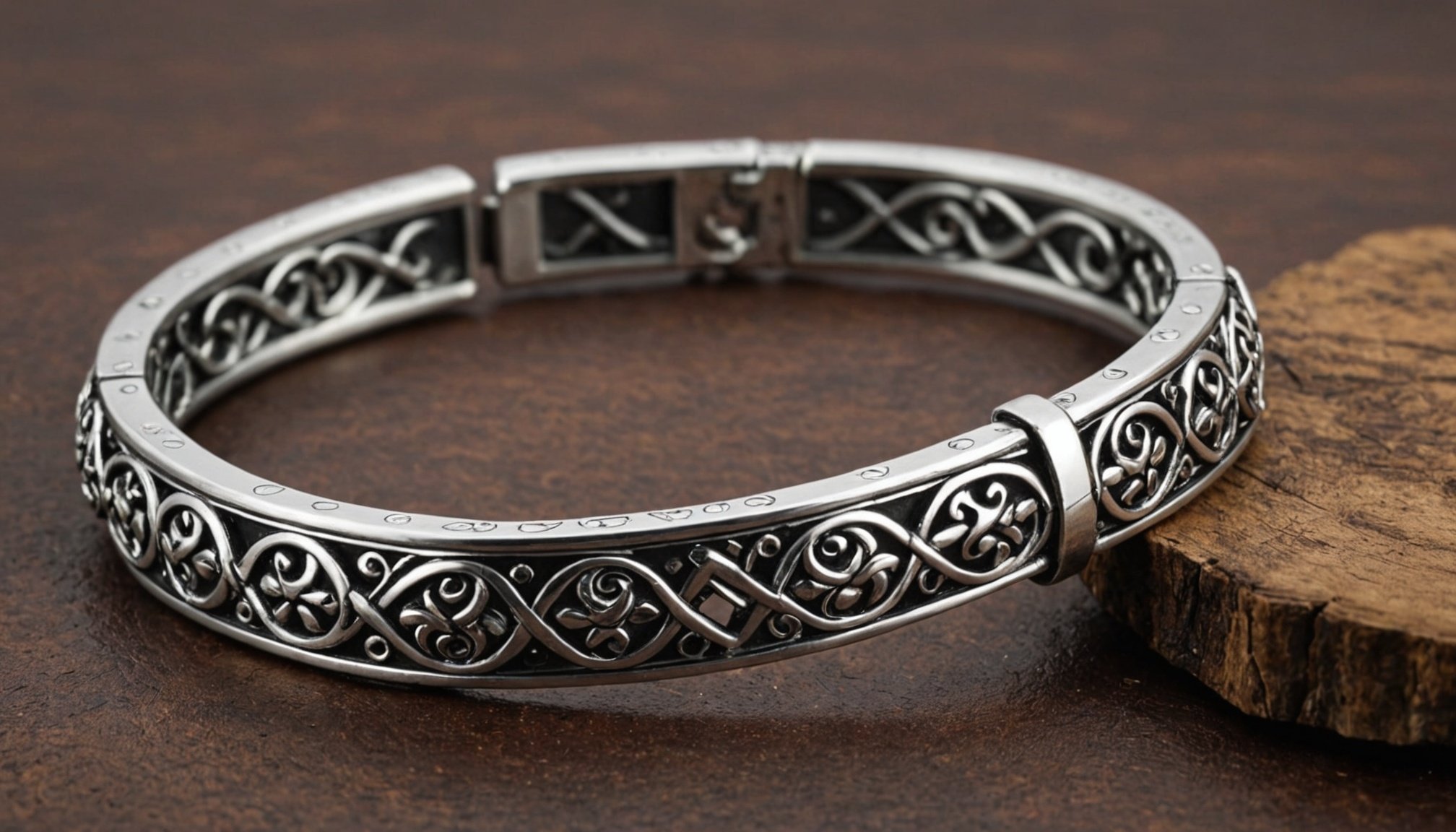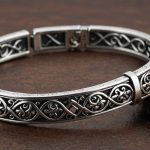Uncover Silver Viking Bracelets for Timeless Style and Grace
When it comes to jewelry that combines historical significance with timeless elegance, few pieces stand out as much as the silver Viking bracelets. These intricate and often symbolic pieces of jewelry have been a cornerstone of Viking culture, reflecting not only their craftsmanship but also their deep connection to their beliefs and way of life. Let’s delve into the world of silver Viking bracelets and explore their history, significance, and why they remain a coveted item for many today.
The Historical Context of Viking Bracelets
To appreciate the beauty and importance of silver Viking bracelets, it’s essential to understand the historical context in which they were created. During the Viking Age, jewelry was not just a form of adornment but also served multiple purposes such as currency, tokens of loyalty, and symbols of spiritual connection1.
Also to see : Discover premium techwear options to enhance your wardrobe
Viking bracelets, particularly those made from silver, were highly valued for their durability, aesthetic appeal, and practical uses. For instance, hacksilver arm rings were made of silver and could be broken into smaller pieces to facilitate trade and barter. This practice highlights the practicality of Viking society, where wealth needed to be both portable and divisible1.
Types of Silver Viking Bracelets
Silver Viking bracelets come in various forms, each with its unique characteristics and significance.
Topic to read : Discover stylish chloe sneaker collections to enhance your style
Metal Bracelets: The Quintessential Viking Jewelry
The most well-known type of Viking bracelet is the metal arm ring, often crafted from precious metals like silver, bronze, iron, and gold. These Viking torc bracelets were twisted into elegant designs and served as jewelry, currency, and tokens of loyalty. They were also used in religious settings and for swearing oaths. Kings and chieftains would gift these bracelets to their warriors to solidify alliances and reward loyalty1.
Hacksilver Arm Rings: The Dual Role of Viking Wealth
Hacksilver arm rings are particularly intriguing due to their dual role as both jewelry and currency. These rings were made of silver, sometimes decorated, but not exclusively ornamental. They could be cut or broken into smaller pieces to facilitate trade, making them a practical and versatile form of wealth1.
Materials and Craftsmanship
The materials used in Viking jewelry were carefully chosen for their symbolic and practical properties.
Silver: A Valued Metal
Silver was highly valued for its antimicrobial qualities, which made it a practical choice for jewelry when hygiene was limited. It was also associated with strength and resilience, making it accessible to individuals of various social ranks2.
Craftsmanship: Precision and Purpose
The creation of Viking jewelry involved advanced techniques for the time, including casting, engraving, and filigree work. Artisans were highly skilled and took great care in crafting each piece to ensure it aligned with its intended purpose. The precision of their designs allowed for the creation of intricate patterns that carried symbolic meanings, such as knotwork, which represented the interconnectedness of life and eternity2.
Symbolism and Protective Powers
Viking jewelry, including silver bracelets, was not just a display of craftsmanship and wealth but also a symbol of protection and connection to the spiritual world.
Protective Symbols
Symbols like Thor’s Hammer (Mjölnir), The Valknut, and The Helm of Awe (Ægishjálmur) were popular choices for pendants and amulets. These symbols were believed to provide protection in battle, ensure safety during long journeys, and invoke the protection and favor of specific gods2.
Material Energy
Gemstones and natural materials like amber were incorporated into Viking jewelry for their believed healing properties and ability to ward off evil spirits. Amber, known as the “gold of the North,” was particularly valued for its warm, golden hue and its perceived mystical properties2.
Examples and Collections
To get a closer look at these magnificent pieces, several museums and collections are worth exploring.
The Cuerdale Hoard
The Cuerdale Hoard, discovered along the River Ribble in Lancashire, England, includes numerous Viking metal bracelets, coins, and hacksilver pieces. This treasure trove is one of the richest selections of Viking bracelets and can be found at the British Museum1.
National Museum of Denmark
The National Museum of Denmark features an extensive collection of metal jewelry, tools, and reconstructed Viking crafts. This museum is a great resource for understanding the craftsmanship and significance of Viking bracelets1.
Practical Insights and Modern Appeal
Despite being centuries old, silver Viking bracelets continue to captivate people today for their timeless style and historical significance.
Why Choose a Silver Viking Bracelet?
- Timeless Elegance: Silver Viking bracelets offer a unique blend of historical charm and modern elegance, making them a versatile accessory for any occasion.
- Craftsmanship: The intricate designs and advanced techniques used in crafting these bracelets reflect the exceptional skill of Viking artisans.
- Symbolic Meaning: Each piece carries deep cultural and mystical significance, making it more than just a piece of jewelry.
- Durability: Silver is a durable metal, ensuring that these bracelets can be worn and cherished for generations.
How to Choose the Right Silver Viking Bracelet
When selecting a silver Viking bracelet, here are some key points to consider:
Authenticity
- Look for pieces that are inspired by or replicas of actual Viking artifacts. Museums like the British Museum and the National Museum of Denmark offer authentic examples to draw from1.
Material
- Ensure the bracelet is made from high-quality silver. Sterling silver is a good option as it is durable and maintains its shine over time.
Design
- Choose a design that resonates with you. Whether it’s a simple arm ring or a more intricate piece featuring symbols like Thor’s Hammer, the design should reflect your personal style and connection to the Viking culture.
Price
- Be prepared for a range of prices. Authentic or high-quality replicas can be more expensive, but they offer a level of craftsmanship and historical significance that is hard to match with cheaper alternatives.
Reviews and Testimonials
Many people who have purchased silver Viking bracelets have shared their positive experiences:
- “I was amazed by the craftsmanship of my silver Viking bracelet. It’s not just a piece of jewelry; it’s a piece of history.” – Emily R.
- “The attention to detail in the design is incredible. It feels like I’m wearing a piece of the past.” – John D.
Silver Viking bracelets are more than just pieces of jewelry; they are windows into a rich and fascinating culture. With their intricate designs, symbolic meanings, and historical significance, these bracelets offer a timeless style and grace that continues to captivate people today.
Whether you’re drawn to the protective powers of these symbols, the exceptional craftsmanship, or the simple elegance of the designs, a silver Viking bracelet is a unique and meaningful addition to any jewelry collection.
For those interested in exploring more about Viking jewelry and its historical context, you can start by reading more about the subject here.
Detailed List of Viking Bracelet Types
Here is a detailed list of the various types of Viking bracelets that have been found in archaeological digs:
-
Metal Bracelets:
-
Made from precious metals like silver, bronze, iron, and gold.
-
Often twisted into elegant designs.
-
Used as jewelry, currency, and tokens of loyalty.
-
Examples include hacksilver arm rings and oath rings1.
-
Beaded Bracelets:
-
Made from materials like amber, glass, ceramic, and other delicate items.
-
Popular among Viking women.
-
Symbolized wealth, spiritual connection, and access to trade routes1.
-
Rock and Crystal Bracelets:
-
Made from materials like rock crystal, amethyst, jet, and similar minerals.
-
Found in excavations at major Viking sites like Birka and Kaupang.
-
Often strung together to create charm bracelets or shaped as solid bracelets1.
-
Clasp Bracelets:
-
Used as wrist-clasps, particularly in female costumes in England.
-
Found in both male and female graves across Scandinavia and England.
-
Exhibited remarkable consistency in construction from the Roman Iron Age through the Viking Age1.
-
Bone and Antler Bracelets:
-
Although no direct archaeological examples have been found, these materials were commonly used in other forms of Viking jewelry and craftsmanship.
-
Likely featured carved geometric patterns, runes, or animal motifs1.
Comparative Table of Viking Bracelet Materials
Here is a comparative table highlighting the different materials used in Viking bracelets and their significance:
| Material | Significance | Practical Use | Symbolic Meaning |
|---|---|---|---|
| Silver | Valued for antimicrobial qualities and strength | Used as currency and in hacksilver arm rings | Associated with strength and resilience |
| Bronze | Affordable and widely accessible | Used in everyday jewelry and protective symbols | Associated with strength and resilience |
| Gold | Symbol of divine favor and wealth | Used in offerings to gods and elite jewelry | Symbol of wealth and divine favor |
| Amber | Believed to possess healing properties and ward off evil spirits | Used in amulets and decorative pieces | Symbol of spiritual connection and healing properties |
| Rock Crystal | Appreciated for its beauty and perceived mystical properties | Used in charm bracelets and solid bracelets | Symbol of elegance and sophistication |
| Jet | Associated with magical or protective properties | Used in bracelets and rings found across the North Atlantic | Symbol of protection and spiritual connection |
By exploring the world of silver Viking bracelets, we not only appreciate the craftsmanship and historical significance of these pieces but also connect with a culture that valued both science and spirituality. Whether you’re a history enthusiast, a jewelry collector, or simply someone who appreciates timeless elegance, a silver Viking bracelet is a unique and meaningful addition to any collection.











